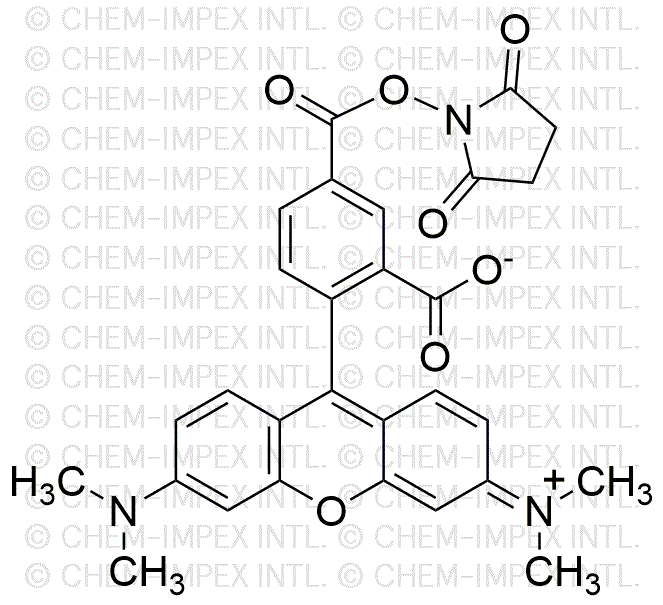5-Carboxy-tetramethylrhodamine N-succinimidyl ester is widely utilized in research focused on:
- Fluorescent Labeling: This compound is commonly used in biological research for labeling proteins and antibodies. Its bright fluorescence allows researchers to track and visualize cellular processes in real-time.
- Immunofluorescence Assays: It plays a crucial role in immunofluorescence techniques, enabling the detection of specific antigens in cells or tissue sections. This application is vital in diagnostics and research in fields like cancer and immunology.
- Flow Cytometry: The compound is utilized in flow cytometry to analyze cell populations. Its fluorescent properties help in distinguishing between different cell types based on their surface markers, facilitating advanced research in hematology and cell biology.
- In Vivo Imaging: Researchers use this chemical for in vivo imaging studies, where it aids in tracking biological processes within living organisms. This application is particularly beneficial in drug development and disease progression studies.
- Bioconjugation: It is effective for bioconjugation, where it links biomolecules to other entities like nanoparticles or drugs. This enhances the specificity and efficacy of therapeutic agents, making it a valuable tool in targeted drug delivery systems.
Informations générales
Propriétés
Sécurité et réglementation
Applications
5-Carboxy-tetramethylrhodamine N-succinimidyl ester is widely utilized in research focused on:
- Fluorescent Labeling: This compound is commonly used in biological research for labeling proteins and antibodies. Its bright fluorescence allows researchers to track and visualize cellular processes in real-time.
- Immunofluorescence Assays: It plays a crucial role in immunofluorescence techniques, enabling the detection of specific antigens in cells or tissue sections. This application is vital in diagnostics and research in fields like cancer and immunology.
- Flow Cytometry: The compound is utilized in flow cytometry to analyze cell populations. Its fluorescent properties help in distinguishing between different cell types based on their surface markers, facilitating advanced research in hematology and cell biology.
- In Vivo Imaging: Researchers use this chemical for in vivo imaging studies, where it aids in tracking biological processes within living organisms. This application is particularly beneficial in drug development and disease progression studies.
- Bioconjugation: It is effective for bioconjugation, where it links biomolecules to other entities like nanoparticles or drugs. This enhances the specificity and efficacy of therapeutic agents, making it a valuable tool in targeted drug delivery systems.
Documents
Fiches de données de sécurité (FDS)
La FDS fournit des informations de sécurité complètes sur la manipulation, le stockage et l’élimination du produit.
Spécifications du produit (PS)
Le PS fournit une description complète des propriétés du produit, notamment sa composition chimique, son état physique, sa pureté et les exigences de stockage. Il détaille également les plages de qualité acceptables et les applications prévues du produit.
Certificats d'analyse (COA)
Recherchez des certificats d'analyse (COA) en saisissant le numéro de lot du produit. Les numéros de lot et de lot se trouvent sur l'étiquette d'un produit, après les mots « Lot » ou « Lot de fabrication ».
Numéro de catalogue
Numéro de lot/série
Certificats d'origine (COO)
Ce certificat d'exploitation confirme le pays dans lequel le produit a été fabriqué, et détaille également les matériaux et composants utilisés et s'il est issu de sources naturelles, synthétiques ou autres sources spécifiques. Ce certificat peut être requis pour les douanes, le commerce et la conformité réglementaire.
Numéro de catalogue
Numéro de lot/série
Fiches de données de sécurité (FDS)
La FDS fournit des informations de sécurité complètes sur la manipulation, le stockage et l’élimination du produit.
DownloadSpécifications du produit (PS)
Le PS fournit une description complète des propriétés du produit, notamment sa composition chimique, son état physique, sa pureté et les exigences de stockage. Il détaille également les plages de qualité acceptables et les applications prévues du produit.
DownloadCertificats d'analyse (COA)
Recherchez des certificats d'analyse (COA) en saisissant le numéro de lot du produit. Les numéros de lot et de lot se trouvent sur l'étiquette d'un produit, après les mots « Lot » ou « Lot de fabrication ».
Numéro de catalogue
Numéro de lot/série
Certificats d'origine (COO)
Ce certificat d'exploitation confirme le pays dans lequel le produit a été fabriqué, et détaille également les matériaux et composants utilisés et s'il est issu de sources naturelles, synthétiques ou autres sources spécifiques. Ce certificat peut être requis pour les douanes, le commerce et la conformité réglementaire.


